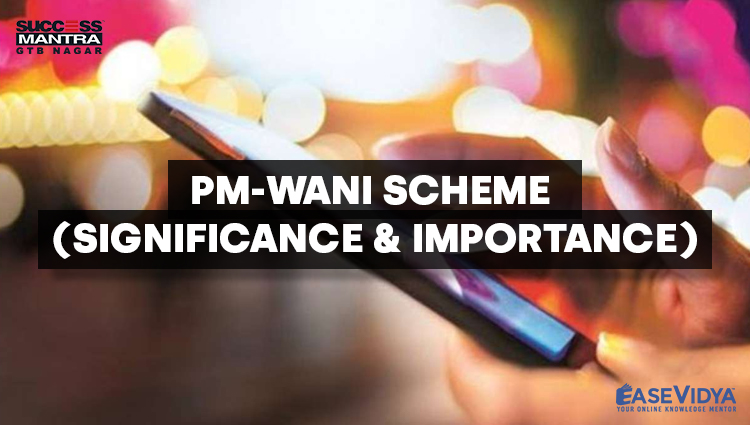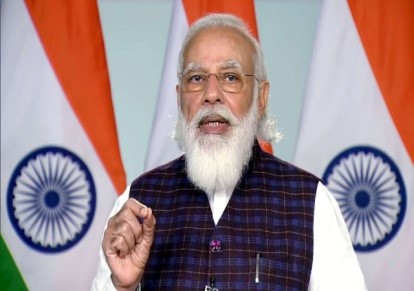
PM WANI SCHEME SIGNIFICANCE AND IMPORTANCE
PM-WANI SCHEME (SIGNIFICANCE & IMPORTANCE)

The Union Cabinet led by PM Modi has approved the setting up of public Wi-Fi networks across the length and breadth of the country on December 9, 2020. The public Wi-Fi network service is to be called as PM Wi-Fi Access Network Interface or WANI scheme. It would be set up by the public data office aggregators or PDOAs and would provide Wi-Fi service through the public data offices or PDO's. No license fee will be charged for providing broadband internet services. The scheme envisages setting up of public Wi-Fi networks and access points by local Kirana and neighbourhood shops through public data offices (PDO will be set up on the lines of Public Call Offices (PCOs)) that will not involve any licence, fee or registration. Apart from, Public Wi-Fi being a low-cost option to reach unserved citizens and grow the economy, it can revolutionise the tech world and significantly improve Wi-Fi availability across the length and breadth of India.
INTENDED BENEFITS OF THE SCHEME
• New wave of Internet Users: PM WANI will be able to connect a new wave of users not just to commercial and entertainment options, but also to education, telehealth and agriculture extension, and bring greater accountability to the government by boosting transparency and interactivity.
• Enabler for Digital India: The scheme would enable small shopkeepers to provide Wi-Fi service. This will boost incomes as well as ensure youth gets seamless internet connectivity. It can also strengthen the Digital India mission.
• Cutting The Red Tape: Through PM WANI, the government is hoping that by cutting through layers of bureaucracy and eliminating licences and fees, it can make it easy even for a tea shop owner to register online as a service provider, opening up new income avenues.
• Domino Effect on Economy: According to the TRAI report, public Wi-Fi system on the WANI architecture can lead to a 10% rise in net penetration which in turn can lead to a 1.4% increase in GDP.
• Bridging the Digital Divide: PM WANI can result into a rapid scale-up of the Internet in rural India, which will be transformative, given the low level of penetration — 27.57 subscribers per 100 population in 2019. Wi-fi linked to broadband fibre service can be the fastest route to bridging the existing gap.
• Low-Cost Alternative: Upcoming mobile technologies such as 5G may provide good quality data, but they involve high investment in the new spectrum, connectivity equipment and regular subscriber fees. The WANI system offers a way forward to connect low revenue consumers.
OTHER OBJECTIVES OF PM-WANI SCHEME

PM-WANI scheme would introduce more business-friendly environment by boosting ease of doing business. It aims to provide high-speed internet that has come up as a necessity during the COVID-19 pandemic. High-speed internet is not accessible in areas that do not have a 4G mobile coverage. PM WANI aims to aid the deployment of a public Wi-Fi network service. The proliferation of a public Wi-Fi network will create employment. Enhancement of the disposable incomes is also expected in the hands of small and medium businessmen and this would in turn increase GDP. Using public Wi-Fi hotspots would encourage its penetration across the country. As per TRAI, in various economies, mobile users use WiFi technology to communicate for 50-70% of their net time. But, in India, this figure is less than 10%. In 2018 various service providers stated that they aimed to provide 5 lakh hotspots by March 31, 2019, and 10 lakh hotspots by September 30, 2019. These targets are yet to be achieved. The step of the government of introducing free WIFI is commendable and is expected to increase the number of hotspots.
PROCESS OF PM-WANI SCHEME

The public Wi-Fi access network interface would be an eco-system operated by various players. PM-WANI scheme will work through:
• Public Data Office (PDO): These units would help in establishing, operating the WANI compliant Wi-Fi access points. These would also deliver broadband services to subscribers.
• Public Data Office Aggregator (PDOA): These would aggregate the PDOs and perform all the actions including authorization and accounting.
• App Provider: An application is on cards that would register the users and also look for all the WANI-compliant Wi-Fi hotspots in the local area. It would be displayed within the application for accessing internet service.
• Central Registry: There would also be a central registry maintaining the details of the app providers, PDOAs, as well as PDOs. This central registry will be maintained by C-DoT or Centre of Development for Telematics.
CONCERNS & ISSUES RELATED TO THE SCHEME
• Security Risks: A public WiFI network has several security issues. That’s because several people access the network at the same time on the same spot. Thus public Wi-Fi is at a high risk of sending out confidential data (like passwords, pins etc.) over the network.
• Low Speed: As public WiFI network is usually accessed by several people at the same time, it results in a considerable loss of bandwidth resulting in a slow network speed. It is due to this fact, Google and Facebook’s attempts to provide public Wi-fi got shut down earlier this year.
• Cheap Mobile Data: As per TRAI in 2019, India now has among the cheapest mobile data per GB in the world, with mobile data prices having reduced by 95% in the last five years. As 4G has become cheap and widely accessible, is there still a need to drive Wi-Fi in this manner, rather than the “leapfrogging” of technology that people have frequently talked about in the context of India
CONCLUSION
Strong Cyber-Security Architecture: What the citizen expects is robust service, protection of data integrity, transparency on commercial use of data, and security against cyberattacks. PM WANI should ensure the public data is protected and safe. In this context, the enactment of the public data protection bill, 2019, is the need of the hour.
Ensuring Competition: The government must also ensure true unbundling of hardware, software, apps and payment gateways in the WANI system, as advocated by TRAI, to prevent monopolies. Also, increased competition will address the low data speed issue. If executed properly, the public data offices (PDOs) of PM WANI can do what the PCOs did for phone calls, going well beyond ‘ease of doing business’ to genuinely empower citizens and providing "ease of living".
QUESTIONS (1-5)
Q.1 Which of the following has led the Union Cabinet that has approved the setting up of public Wi-Fi networks across the length and breadth of the country?
A. Prakash Javadekar
B. Narendra Modi: ANSWER
C. Smriti Zubin Irani
D. Ravi Shankar Prasad
Q.2 Which of the following statements is/are incorrect regarding the intended benefits of PM-WANI scheme, recently launched by Union Cabinet?
A. The scheme envisages setting up of public Wi-Fi networks.
B. Public Data Office (PDO) are to set up for operating the WANI compliant
C. It would also set up Quantum Key Distribution system: ANSWER
D. None of the above
Q.3 Which of the following is the correct full form of 'WANI' in PM-WANI scheme?
A. Wi-fi Access Network Interface: ANSWER
B. Wi-fi Aggregators Network Interface
C. Wi-fi Availability & Network Integration
D. None of the above-mentioned
Q.4 Which of the following units of the scheme would help in establishing, operating & registering the WANI compliant Wi-Fi access points?
A. Public Data Office Aggregator (PDOA)
B. Central Registry
C. App Provider
D. Public Data Office (PDO): ANSWER
Q.5 The Telecom Regulatory Authority of India (TRAI) is the regulator of the telecommunications sector in India is headquartered at which of the following places?
A. Mumbai, Maharashtra
B. New Delhi: ANSWER
C. Gurugram, Haryana
D. Pune, Maharashtra













0 Comment